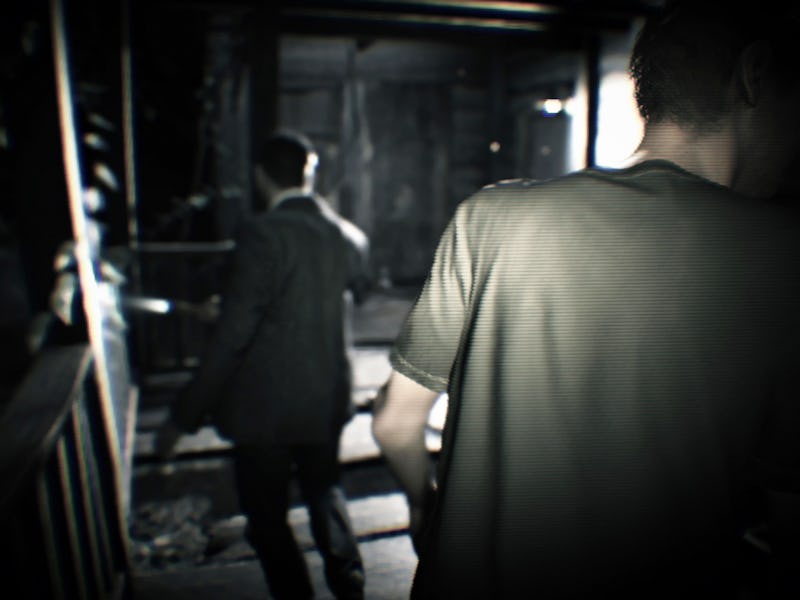'Resident Evil 7' Builds Anticipation in the Perfect Way
Capcom's teaser is a great example of tension and mystery.

I’ve played through Capcom’s Resident Evil 7 teaser Beginning Hour more than a dozen times, and I still don’t know how everything in it works. I’ve scoured what feels like every inch of the setting’s rotting, dilapidated country house and experimented with various combinations of when to do what actions to gauge potential changes. After the game received it’s final of three updates this weekend, I’ve even finished it with what I feel like are all the possible endings. And yet there are still mysteries left unsolved. It’s unexpected enough to be — quite frankly — a little amazing.
Beginning Hour can’t touch Hideo Kojima’s Silent Hills teaser P.T., but it has a similarly opaque feel (likely in no small part because Capcom hired Kojima Productions’s Jordan Amaro to work on RE7’s development) and smart approach. The opening has an elegant and probably knowing parallel to Kojima’s work: You wake up on the ground of an empty house in first person, then slowly stand up as the player watches the camera right itself.
The nod is near identical to P.T.’s opening, only instead of in a cement room within a well-worn and seemingly quiet home whose layers slowly peel back to reveal a vessel of hell, you’re in a ramshackle domicile with walls clotted by rot and foundations sagging from extreme disuse. It’s dark — of course it’s dark — and there’s an old CRT television and VCR glowing in the corner. The game’s instructions are straightforward: “Get out of the house.”
Gameplay in Beginning Hour seems to be something of a variation on P.T. as well, involving a lot of quiet observation and seeing what you may be able to interact within the environment. Since the first version of the demo was released over the summer, there was never any real danger; as you move through one disconcerting space after another, the teaser does an excellent job of getting under your skin simply because you don’t know for sure. Unlike P.T., there is very little non-diegetic sound work, so any exploration you want to attempt is done in almost complete silence, with only the occasion pop, creak, or muffled noise to further add strain to your psyche.
Beginning Hour is also unexpectedly weird. If you look around the house, you can find a tape that can be played in the VCR (itself a nested prequel to Capcom’s RE7 VR demo Kitchen, which takes place later on from the tape’s contents in the same setting). “Watching” the footage is done from a playable perspective, embodying the POV of a cameraman filming a couple of small-time TV producers breaking into the house to film a paranormal-leaning reality show.
When the video ends with the gruesome death of a producer, you jump back to the real world only to find a note seen earlier (“I shall dash them against the stones.”) now sitting on the table in front of you, with the “them” scratched out and replaced by “YOU.” It’s unnerving stuff.
More to the point: items, and how they are used, are an effective design Beginning Hour takes advantage of to manufacture tension. There are locks that won’t open, doors that stay stiffly closed, and items that may or not have a purpose, all factors that compounded in the way that Beginning Hour has subtly, and sometimes not so subtly, changed over the course of its three releases.
The most prominent of these is probably the mannequin finger, found in a hallway drawer and seemingly completely pointless. Eventually, you find a celluloid hand to attach it to, though whether or not that gets you any closer to figuring out its purpose is unknown. Naturally, fans online have been feverishly trying to decipher the riddle for months, and despite having personally steered clear from reading anything about the game’s obtuse puzzles in a possibly vain attempt to solve them myself, they prove a point.
Considering the mannequin finger, the locked drawer in the kitchen, the shut door on the third floor, and the recording’s effects on the real world, it’s easy to start wanting to experiment. What happens if you don’t put the fuse — needed to access the third floor and whose location is dependent on knowledge you get from the recording — into the fusebox before watching the tape?
What about leaving the mannequin finger in the drawer where you find it and checking it in the tape instead? How about if you pick up the back door key and then try to leave out the window on the third floor? Or if there’s any change whether you find the photograph with the Umbrella logo chopper on it, or whether to pick up the phone or not? And most of all, what stomach-pitting dread might result from it?
To some degree, it’s an illusion. You don’t need these questions solved in order to make it through the actual linear path Beginning Hour finally resolves in its last update. Regardless, if you can resist looking up the answers online, the game encourages testing parameters out during replays.
It would also be flat-out wrong to suggest that whatever causes something in the teaser’s systems to change, or how many layers were even possible to see before the final update, doesn’t cause some consternation. Beginning Hour’s design progression cleverly adds enough small wrinkles, whether aural or visual, to thoroughly rattle you. And when, as here, you have no idea over the weight of your actions — or even if there is any — mind games bear the same fruit. It’s the best kind of horror; the kind that makes you feel a little unhinged.